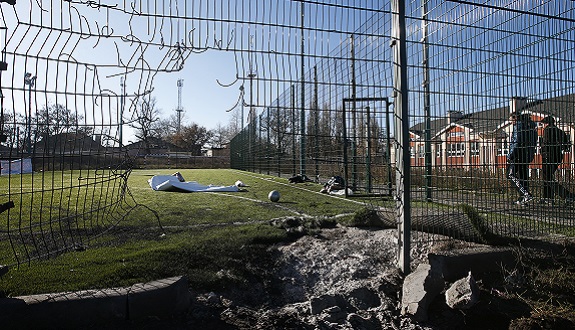GCPEA News
25 Years after Landmark Treaty, Children’s Rights Still Violated with Impunity in Conflict
GCPEA Press Release, November 20, 2014
On the 25th anniversary of the Convention on the Rights of the Child (CRC), the Global Coalition to Protect Education from Attack (GCPEA) calls on states to safeguard children’s rights to life and education by addressing widespread attacks on schools, teachers, and students, and military use of education buildings during war. In 1989, world leaders recognized the rights of all children by adopting the CRC, the most widely ratified international human rights treaty in history. Yet, a quarter of a century later, the right to education enshrined in the CRC remains merely aspirational for some of the globe’s most vulnerable girls and boys in some of its most dangerous places: half of the world’s nearly 58 million out-of-school children of primary school age live in conflict-affected states.
“Children are recruited into armed groups from school, their classrooms are intentionally bombed and burned to gain military advantage, and their playgrounds are used to train or house troops, heightening the risk of attack by opposing forces,” said GCPEA Director Diya Nijhowne. “Clearly there is still a broad gap between the vision articulated in the CRC and the reality for young people trying to access education in countries impacted by war.”
To date, 194 countries — all but three — have ratified the legally binding treaty, committing to respect, protect, and fulfill children’s rights, including during war. This involves taking measures to prevent abuses, even by non-state actors, investigating abuses, and holding perpetrators accountable. In evaluating conflict-affected states such as Afghanistan, Myanmar, and Syria, the Committee on the Rights of the Child — the UN body responsible for monitoring implementation of the treaty — has repeatedly urged governments to take all possible measures to protect schools, students, and teachers from attack and seizure by armed parties.
In its report Education under Attack 2014, GCPEA documented a significant pattern of attacks on schools, students, and education personnel in 30 countries between 2009 and 2013. GCPEA has also found that education institutions were used for military purposes — as bases, barracks, weapons caches, and detention centers — in 25 countries between 2005 and 2014.
“Many rights the CRC guarantees — to life, health, protection from violence, and education — are violated when students and teachers are abducted, raped, maimed, and killed, and schools are damaged and destroyed, or used by armed parties,” said Nijhowne. “Governments must live up to their commitment to protect children’s rights and prioritize the safety of schools and their students and staff.”
In recent months, attacks have occurred in disparate contexts across different regions. October 1st was a particularly bloody day for education, with reports of attacks on schools in Syria, the Ukraine, and Pakistan resulting in the deaths of students and teachers, as well as significant damage to school buildings. November 5th again saw multiple attacks on schools in Syria and the Ukraine, with at least 13 children killed when a primary school in eastern Damascus was struck by mortar fire, and two teens killed while playing football on school grounds in Donetsk.
The Islamist militant group Boko Haram has continued to wage war on education in northeastern Nigeria. On November 10th, a suicide bomber disguised as a student entered a secondary school for boys in Potiskum in Yobe state and detonated explosives during morning assembly. Boko Haram is suspected in the attack, which killed at least 58 people and injured 117 others, according to school officials. The following day, a female suicide bomber targeted a teachers’ college in the western state of Niger. Nigeria ratified the CRC in 1991.
“Children in conflict situations cannot afford to wait another 25 years before governments deliver on the promises set out in the CRC,” said Nijhowne. “One concrete action states can take to better realize their obligations is to endorse and implement the Draft Lucens Guidelines for Protecting Schools and Universities from Military Use during Armed Conflict.”
The Guidelines provide practical guidance to states and non-state armed groups for planning and executing military operations to ensure that schools and students are protected. Developed by GCPEA through extensive consultations with states and championed by the government of Norway, the final Guidelines will be unveiled in Geneva next month.
Additional Resources:
- Video: Education Under Attack
- Video: End Military Use of Schools
- Questions and Answers on the Draft Lucens Guidelines (PDF)
Image: Damage caused by shelling on a school’s playing field in Donetsk, eastern Ukraine, 6 November 2014. Two teenagers died and four were wounded when an artillery shell hit the field as they played football.
© 2014 REUTERS/Maxim Zmeyev
The Global Coalition to Protect Education from Attack (GCPEA) is a coalition of international organizations, including CARA (Council for At-Risk Academics), Human Rights Watch, the Institute of International Education’s Scholar Rescue Fund, Protect Education in Insecurity and Conflict, SAIH (the Norwegian Students’ and Academics’ International Assistance Fund), Save the Children, the Scholars at Risk Network, UNHCR, UNICEF, and War Child Holland. GCPEA is a project of the Tides Center, a nonprofit 501(c)(3) organization. Learn more at www.protectingeducation.org.





